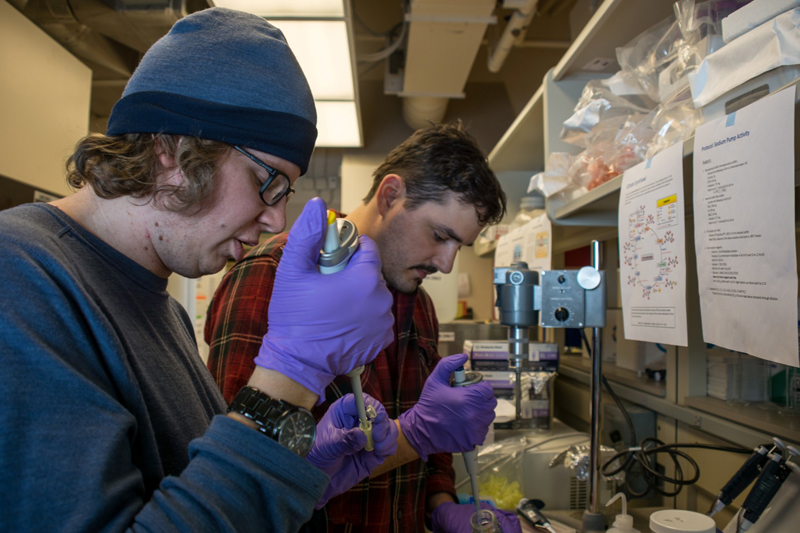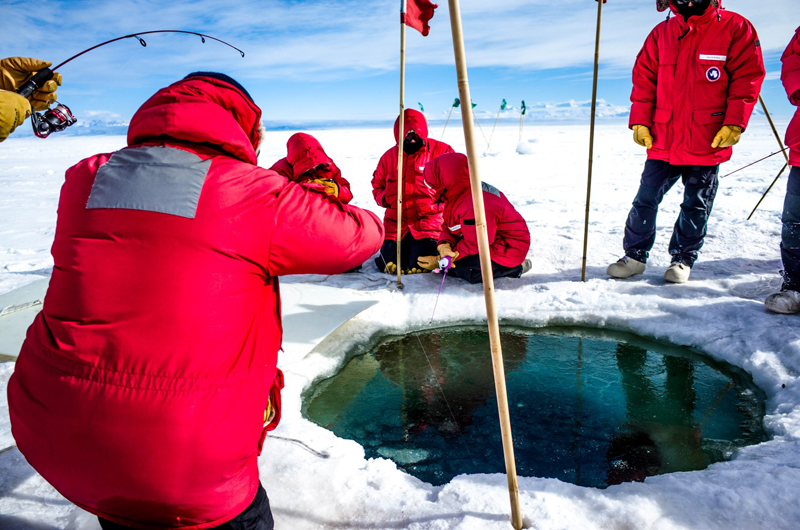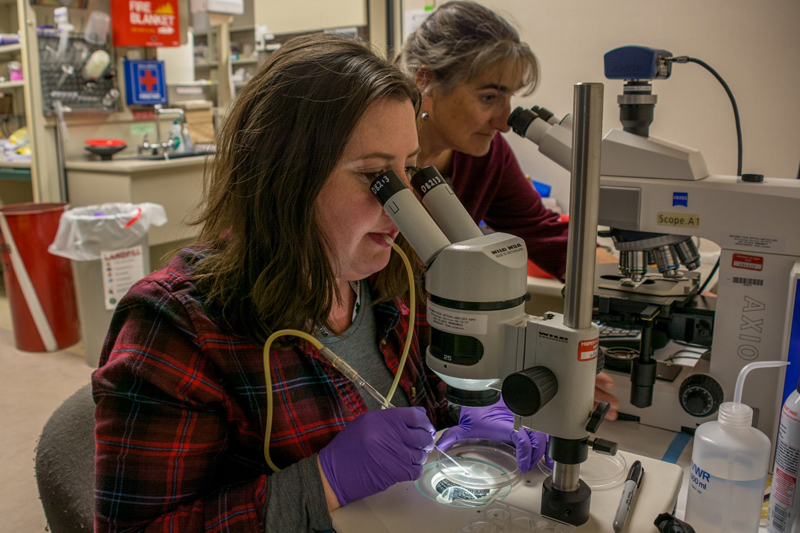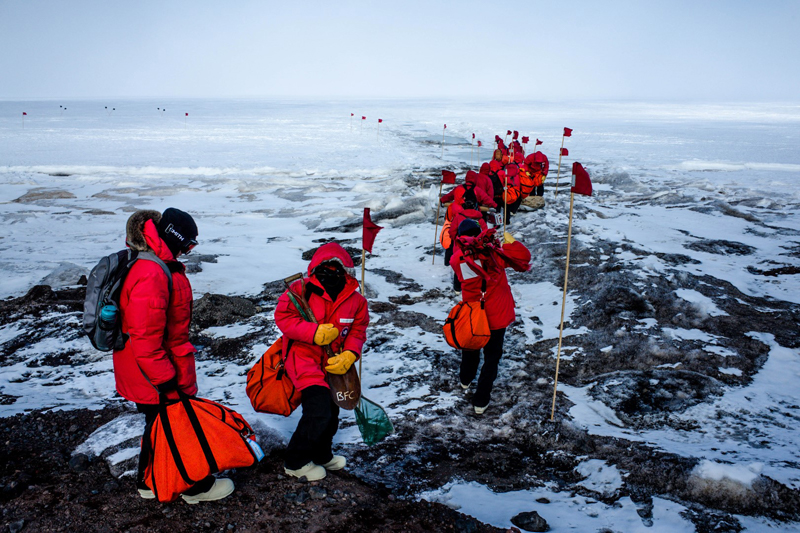A World-Class Classroom at the Bottom of the WorldStudents Learn Antarctic Science and Logistics First-Hand at McMurdo StationPosted May 31, 2018
For early-career scientists, learning the ropes in Antarctica can mean donning actual safety lines and harnesses. 
Photo Credit: Mike Lucibella
Students Joshua Lonthair (foreground) and Brandon Hassett process samples collected on the sea ice next to the station.
This past austral summer, 20 students traveled to the National Science Foundation’s McMurdo Station to conduct a range of experiments and learn first-hand what it’s like to do research at the bottom of the world. They were part of the NSF Advanced Training Program in Antarctica for Early Career Scientists, which brings researchers who recently received doctorates, or who are still in graduate school, to McMurdo to spend six weeks conducting field research. The program is nearing its 25th anniversary. “It’s a project that is about training the next generation,” said Donal Manahan, a professor of biology at University of Southern California and the lead organizer of the program. “Our concept is to find lots of bright, early career, motivated scientists who want into Antarctic science. They have a lot of skillsets and then we bring them down as a team to address complex questions.” The idea behind the program is twofold. It’s to teach the participants about the science being done in the polar regions, while also giving them experience developing field plans and a feel for the complex logistics needed to work in the field. “It gives early career scientists a chance to come to Antarctica and see what it’s like to work in this environment,” said Deneb Karentz, a professor at the University of San Francisco and a co-leader of the program. 
Photo Credit: Ana Lyons
Student participants catch fish from a hole in the sea-ice near McMurdo Station.
The training is funded by NSF, which manages the U.S. Antarctic Program. For early career researchers, getting Antarctic field experience can be difficult, particularly if they’re not otherwise attached to an advisor or professor who works on the continent. “We try to find people who haven’t had an opportunity to actively participate in Antarctic field research,” said Sam Laney, a researcher at the Woods Hole Oceanographic Institution and another project co-leader. “We give them a chance to show them what it’s like, give them access to the environment and to the tools, and give them sort of a little sandbox for a while for what it’s like to be a real Antarctic researcher.” Though the participants in the program are referred to as “students,” they’re investigating serious scientific problems. The six senior professors and two teaching assistants who run the course, help guide the 20 students towards questions that haven’t been answered yet. “Everything is scientifically new, there’s nothing happening that we know the answer to. It’s a real research level of expedition,” Manahan said. “We’ve actually published quite a number of scientific papers from this program over the years, real novel science.” For the students, a large part of the program is about exposing them to research areas they may not have worked in before. It can mean collecting water samples from holes drilled in the ice near the station, or donning safety equipment and visiting the edge of the sea ice. “It’s a very wide ranging course,” Manahan said. “It’s not focused on one organism or one level of biological analysis. It’s very integrative and very diverse.” The hope is that by bringing together early career scientists from a variety of disciplines, by working closely together they’ll be able to come up with original and inventive directions for their research. “There’s quite a bit of synergistic activity,” Karentz said. “From year to year it changes quite a bit, but within any given year the kinds of folks that are involved range from people who are modelers who have never been out in the field before, to people that do a lot of field work but have never worked in a laboratory setting and don’t know much about biochemistry. So you get all of these early career scientists together and you just kind of watch them interact.” 
Photo Credit: Mike Lucibella
Student Ana Lyons (foreground) uses a kind of suction tweezers to move microorganisms around under the microscope, while Deneb Karentz peers through a microscope.
In addition to the research, another aim of the course is to get the students to think about how to plan polar research projects should they someday propose their own projects. “[The idea is] to have early career scientists at a critical point in their career be exposed to the exciting questions of polar science, how to do it logistically and how to plan to do science in these remote regions, and then to come down and to lead their own scientific groups later in their careers,” Manahan said. Giving the students a hands-on research experience on the continent itself helps prepare them for future projects they may want to propose. “It helps them be realistic so they don’t write unreasonable, or completely undoable projects.” Laney said. “They have a good sense of what’s a tractable field program down here.” Because the continent is so remote, with a dangerous environment and limited resources, researchers with no Antarctic experience sometimes have a difficult time developing projects within the sweet spot of being broad enough scope to be scientifically significant, but narrow enough to be supportable. “If you’ve never been here before, it’s very difficult to put together a proposal that’s going to be viewed as viable,” Karentz said. “Having the opportunity to come down, see what it’s like to go out, make a hole in the ice, collect a water sample, get it back here, process it in a lab, all of that kind of thing, is going to be very helpful when someone sits down to come up with their own project.” Kathleen Craft, a researcher at the Johns Hopkins Applied Physics Laboratory, said that part of the first-hand learning is coming up with ways to roll with setbacks when things don’t go exactly as planned. “You’re down here for a certain period of time, and if your plan A doesn’t go right, you should really have a plan B or even a plan C just to still accomplish something while you’re here and not have it be a total loss,” Craft said. 
Photo Credit: Mike Lucibella
Student Ana Lyons studies microorganisms under a microscope. She’s trying to understand why the cells of certain animals expend so much energy on a cellular process known as the sodium-potassium pump.
Back home, she’s helping to develop NASA’s Europa Clipper mission, a space probe to study Jupiter’s icy moon Europa. The hope is that someday a future mission might include a lander to explore the moon’s frozen surface, or even the oceans below its thick layers of ice. “On Earth, we don’t have any kind of perfect analogue to what we’re hoping to get to someday when we get to Europa, but this is one of the best analogs that you can get,” Craft said. She spent the season studying how microbes that live underneath the Antarctic ice, move up through the ice through cracks and brine channels. “I actually don’t have a biology background. My background is in geophysics and engineering,” Craft said. “I saw this as a really good opportunity for me to learn a lot about biology in general, particularly about how it adapts down here, but also to learn a lab process that I’m not familiar with.” Ana Lyons, a third-year doctoral student at the University of California Berkeley, is building on the surprising finding her instructor made about sea urchins during a previous field season. The cells of the animal use nearly eighty percent of their energy to maintain a cellular process known as the sodium-potassium pump. “It’s just this one protein to do this one thing,” she said. “That’s a huge amount of energy just for this one protein.” It’s an important process that all cells have to sustain to keep themselves slightly electrically charged so proteins and other material can more easily move through their membranes. Most biological cells only devote about a third of their energy to the process. “Apparently it takes up a lot energy at really low temperatures,” Lyons said. “We’re trying to see if this is something that carries across other types of lifeforms.” For her, working in Antarctica was a chance get a broader outlook on her science, and a wider perspective on how to conduct research. “So far in a lot of my PhD work I’ve just been in the lab,” Lyons said. “I don’t go out in the field a lot so it’s been really fun for me to see what is out in the field. It really opens up the realm of possibilities to think about what’s happening in natural populations.” Joshua Lonthair, a graduate student at the University of Texas in Austin, likewise wanted to broaden the scope of his work. “I’ve mostly been based in tropical and subtropical climates my whole life,” He said. “I’ve worked in Miami and I’ve worked in Taiwan, but I never worked anywhere colder than that.” He’s studying how climate change might affect the development of fish embryos. He first heard about the program from a post-doctoral student in his lab who participated in a previous class held at NSF’s Palmer Station. Lonthair said he was drawn to new and interesting research in a region that’s been relatively sparsely studied. “I’m excited about doing the science down here, it’s outside my normal,” he said. “Everything is new and so every day I wake up, I’m asking different questions than I would be asking at home. That’s really exciting for a scientist to ask different questions.” NSF-funded research in this story: Donal Manahan of the University of Southern California, Award No. 1245703 and Deneb Karentz of the University of San Francisco, Award No. 1245752. |
"News about the USAP, the Ice, and the People"



For USAP Participants |
For The Public |
For Researchers and EducatorsContact UsU.S. National Science FoundationOffice of Polar Programs Geosciences Directorate 2415 Eisenhower Avenue, Suite W7100 Alexandria, VA 22314 Sign up for the NSF Office of Polar Programs newsletter and events. Feedback Form |


